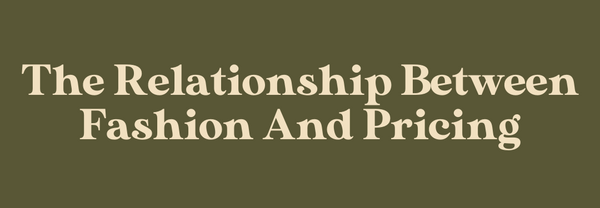Sustainable fashion is a revolutionary movement that aims to reduce the damage inflicted on the planet.
However, if there’s one thing that’s admittedly a little off-putting about sustainable fashion, it’s that it is way more expensive than fast fashion, sometimes even luxury fashion.
For people accustomed to the cutthroat prices of fast fashion, its sustainable counterpart can seem needlessly expensive. But that’s just the thing: there are good reasons for it.
Think about it: sustainable fashion encompasses a whole value system that is in no way easy to uphold. Things like ethical sourcing and paying fair wages cost a lot of money, which ultimately translates to higher prices for sustainable fashion.
Let’s discuss more reasons that should justify and explain why sustainable fashion is more expensive.
Small-scale production is the most salient difference between fast fashion and slow, sustainable fashion. By forgoing the traditional mass production practices of modern capitalist industries, sustainable fashion also forfeits low pricing options.
In fast fashion, products are mass-produced in large factories, which allows them to come out at a lower price. It’s simple economics.
But sustainable fashion actively steers clear of mass production as it is exploitative, both for laborers and the environment. Instead, sustainable fashion attempts to reshape our relationship with clothing by reminding us that clothes shouldn’t be disposable; a lot goes into producing the clothes that you wear, and we should appreciate their value through a slower pace of consumption.
Moreover, while fast fashion fabricates demand, sustainable fashion responds to the actual needs of its consumers.
Small scale production and made-to-order services ensure that only those clothes are produced which people will actually and fully use. While this is less economically efficient, it ultimately produces less waste — whether it's in the production phase or the disposing phase.

Ethical sourcing is an important pillar of the sustainable fashion movement, although it involves various factors.
In short, ethical sourcing means obtaining the natural resources needed for production in ways that minimize impact on the environment. In other words, the source of the material determines its carbon footprint, and sustainable fashion aims to minimize this carbon footprint.
For comparison, fast fashion promotes unsustainable farming practices in order to get as much raw material as possible, producing ungodly amounts of greenhouse gases and toxic waste. It treats animals as commodities, inflicting cruelty upon them in the process. None of this is ethical by any stretch of the word.
It is, however, much cheaper.
On the other end of the spectrum, sustainable fashion brands spare no expense to ensure that they source their raw materials ethically.
Keep in mind, though, that pricing begins with raw materials. Natural fibers, such as silk, hemp, and bamboo, cost way more than polyester-blend materials. As a result, the final price of the product is way higher.

Fair and equitable wages are the backbone of the sustainable fashion movement. They are also one of the main factors that drive up the cost of sustainably-produced clothing.
It is no secret that fast fashion is extremely exploitative of its workers. Even luxury brands grossly underpay their labourers. They typically source their labourers from underdeveloped countries where living standards are low, and worker rights are virtually absent.
Consequently, these big fashion brands can get away with paying their workers way too little.
On the other hand, sustainable fashion is extremely mindful of fair wages. It aims to not only pay labourers minimum wages but to pay them a living wage. This means that the amount of money they earn should be enough for them to lead comfortable and dignified lives.
In fact, the sustainable fashion movement goes a step further and empowers the unemployed, especially women. Training workshops help the locals to master a new skill, which they can use to make a living.
Of course, all of this means that the cost of production for each product increases, which results in high price points for sustainable clothing.
Sustainable fashion aims to uphold and preserve age-old craftsmanship skills, techniques, and knowledge.
Indeed, many sustainable fashion brands will often partner with traditional textile manufacturers in various countries to facilitate them. In fact, it’s more accurate to say that those manufacturers facilitate sustainable fashion brands with their age-old craftsmanship.
Hemp and Hope, for example, was conceived thanks to the knowledge and masterful craftsmanship of local Nepalis. They were already using hemp fiber for manufacturing bags, and their knowledge about this revolutionary fiber is the backbone of the company.
Working side-by-side with artisans achieves two things. First, it conserves traditional skills and knowledge for generations to come. Secondly, it helps ensure the top-tier quality of products that no factories or machines could ever reproduce.
As you can imagine, though, working alongside these small, family-run businesses and borrowing from their generations-old crafts comes at a heavy price. There is limited access to machines and automation, so production naturally costs more.

Sustainable fashion is undeniably more expensive than its more traditional counterparts, particularly fast fashion. But if you look beyond affordability, the low price tag of fast fashion reveals some truly horrifying things.
If we demand cut-price clothing, we’re turning a blind eye to everything it takes to make them that cheap. An excessive amount of natural resources are wasted, laborers are forced to work for less than a dollar an hour, and toxic waste is mindlessly discarded into waterways and landfills since it’s the cheapest thing to do.
Moreover, fast fashion churns out new clothing products every few weeks in massive amounts and slaps on a low price tag to attract customers. Consequently, people start to view clothing as easily disposable and replaceable.
Hence, the low price tag perpetuates the toxic cycle of wasteful, environmentally damaging, and inhumane practices in the fashion industry. The same extends to luxury brands as well, who still pay unfair wages and practice wasteful production.
So, the reason that sustainable fashion seems unreasonably expensive is actually that fast fashion has created unreasonable expectations.
On the other hand, sustainable fashion adheres to multiple values that encompass environmental and human welfare. But you can’t expect ethical sourcing, environmental protection, long-lasting products, and human welfare to come at a low cost.
Fast fashion has spoiled us. Cut-price clothing and other apparel items have conditioned us to believe that clothing should be that cheap.
But think about the true cost of a lower price tag: unethical sourcing, the breach of labor rights, polluting the environment, exploiting workers, and inflicting cruelty on animals.
From this perspective, the pricing behind sustainable fashion makes way more sense and is actually much less questionable. The reason why sustainable fashion is so expensive is simple: it costs a lot to make sure our fashion choices aren’t causing harm to our planet, nor to those who inhabit it.







